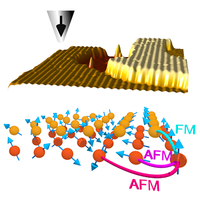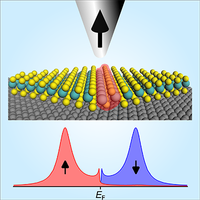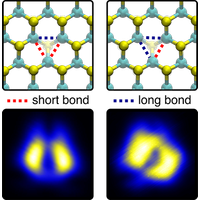Ernst-Ising-Preis für Camiel van Efferen
Der diesjährige Ernst-Ising-Dissertationspreis wurde an Camiel van Efferen verliehen. Der Preis zeichnet herausragende Dissertationen der Fachgruppe Physik an der Universität zu Köln aus und wird gestiftet von der Wilhelm und Else Heraeus Stiftung.
Herzlichen Glückwunsch!
Gaede-Preis für Wouter Jolie
Der diesjährige Gaede-Preis wurde an Wouter Jolie verliehen, in Würdigung seiner herausragenden Beiträge zur Erforschung von Korrelationsphänomenen in niedrigdimensionalen Quantensystemen .
Die Verleihung fand während der diesjährigen DPG Frühjahrestagung in Regensburg statt. Herzlichen Glückwunsch!
Phys. Rev. B 111, L020405 (2025)

Our paper entitled ‘Atomic-scale Dzyaloshinskii-Moriya-modified Yoshimori spirals in an Fe double layer on Ir(110)’ was published in Physical Review B as Editors' Suggestion!
Ultrathin magnetic films on heavy metal substrates with strong spin-orbit coupling enable exploration of novel spin textures and magnetic interactions. While isotropic Ir substrates have been extensively studied, anisotropic fcc(110) surfaces remain overlooked. The authors stabilize here a pseudomorphic Fe double layer on a metastable unreconstructed Ir(110)-(1×1) surface. Spin-polarized scanning tunneling microscopy reveals a magnetically robust right-handed Néel-type magnetic spiral, identified via density functional theory as Yoshimori-type, with the Dzyaloshinskii-Moriya interaction determining the handedness and type of the spiral.
Phys. Rev. Lett. 133, 246701 (2024)

Our paper entilted ‘Spin-Polarized Scanning Tunneling Microscopy Measurements of an Anderson Impurity’ was published in Physical Review Letters as an Editor's Suggestion!
We report spin-polarized scanning tunneling microscopy measurements of an Anderson impurity system in MoS2 mirror-twin boundaries, where both the quantum-confined impurity state and the Kondo resonance resulting from the interaction with the substrate are accessible. Using a spin-polarized tip, we observe magnetic-field-induced changes in the peak heights of the Anderson impurity states as well as in the magnetic-field-split Kondo resonance. Quantitative comparison with numerical renormalization group calculations provides evidence of the notable spin polarization of the spin-resolved impurity spectral function under the influence of a magnetic field. Moreover, we extract the field and temperature dependence of the impurity magnetization from the differential conductance measurements and demonstrate that this exhibits the universality and asymptotic freedom of the S =1/2 Kondo effect. This work shows that mirror-twin boundaries can be used as a testing ground for theoretical predictions on quantum impurity models.
Small, 2408044 (2024)
Our paper entitled ‘Engineering 2D Materials from Single-Layer NbS2’ was published in Small!
Starting from a single-layer NbS2 on graphene, new 2D materials Nb5/3S3-2D and Nb2S3-2D are synthesized via sulfur-deficient annealing or Nb deposition at elevated temperatures. These covalently bound materials exhibit unique structures influenced by surface effects, differing from expected bulk stacking sequences.
Phys. Rev. B 109, 195430 (2024)

Our paper entitled ‘Tip-induced creation and Jahn-Teller distortions of sulfur vacancies in single-layer MoS2’ was published in Physical Review B as Editors' Suggestion!
Vacancies in semiconducting 2D transition metal dichalcogenides enable studies of quantum phenomena at the nanoscale, such as single photon emission or Jahn-Teller distortions. Here, the authors show that a scanning tunneling microscope can enable local creation of single vacancies as well as vacancy dimers in single-layer MoS2. Charging the vacancy through local gating leads to two distinct types of Jahn-Teller distortions, in quantitative agreement with ab initio calculations. Strong hybridization within vacancy dimers illustrates the potential for artificial defect lattices with tailored electronic band structures.
ACS Nano 18, 14161−14175 (2024)
Our paper entilted ‘2D Vanadium Sulfides: Synthesis, Atomic Structure Engineering, and Charge Density Waves’ was published in ACS Nano!
Nano Lett. 24, 1045−1051 (2024)
Our paper entilted ‘Unconventional Charge-Density-Wave Gap in Monolayer NbS2’ was published in Nano Letters!
Nat. Phys. 20, 82–87 (2024)
Our paper ‘Modulated Kondo screening along magnetic mirror twin boundaries in monolayer MoS2’ was published in Nature Physics!
Don't miss the ‘behind the paper’ blogpost by Camiel van Efferen!